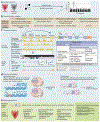The road to precision psychiatry: translating genetics into disease mechanisms
- PMID: 27786179
- PMCID: PMC9012265
- DOI: 10.1038/nn.4409
The road to precision psychiatry: translating genetics into disease mechanisms
Abstract
Hundreds of genetic loci increasing risk for neuropsychiatric disorders have recently been identified. This success, perhaps paradoxically, has posed challenges for therapeutic development, which are amplified by the highly polygenic and pleiotropic nature of these genetic contributions. Success requires understanding the biological impact of single genetic variants and predicting their effects within an individual. Comprehensive functional genomic annotation of risk loci provides a framework for interpretation of neurobiological impact, requiring experimental validation with in vivo or in vitro model systems. Systems-level, integrative pathway analyses are beginning to elucidate the additive, polygenic contributions of risk variants on specific cellular, molecular, developmental, or circuit-level processes. Although most neuropsychiatric disease modeling has focused on genes disrupted by rare, large-effect-size mutations, common smaller-effect-size variants may also provide solid therapeutic targets to inform precision medicine approaches. Here we enumerate the promise and challenges of a genomics-driven approach to uncovering neuropsychiatric disease mechanisms and facilitating therapeutic development.
Conflict of interest statement
COMPETING FINANCIAL INTERESTS
The authors declare no competing financial interests.
Figures


References
-
- Polderman TJC et al. Meta-analysis of the heritability of human traits based on fifty years of twin studies. Nat. Genet 47, 702–709 (2015). - PubMed
Publication types
MeSH terms
Grants and funding
LinkOut - more resources
Full Text Sources
Other Literature Sources

